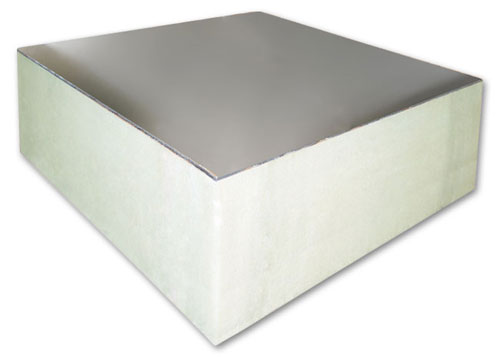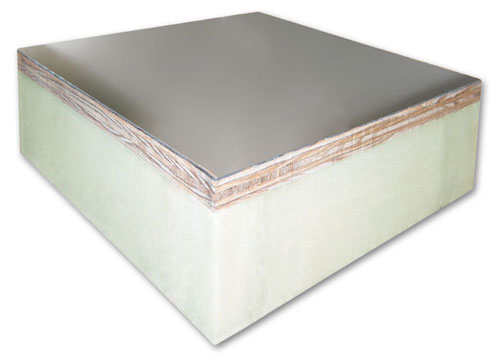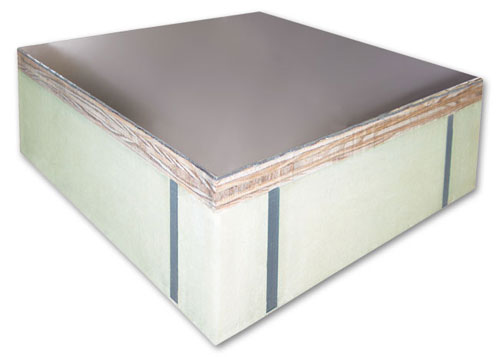Your walk-in cooler or freezer is a considerable business investment. It provides safe and sanitary storage for foods and other products. So, it's essential to ensure your walk-in holds up to the long-term demands of your operation. One of the best ways to do that is to choose the correct flooring.
 An indoor cooler installed on a concrete slab may not need an insulated floor.
An indoor cooler installed on a concrete slab may not need an insulated floor.
Do you need an insulated floor for your walk-in cooler or freezer?
Whether you need an insulated floor depends on a couple of things:
- The walk-in temperature (+32°F or below or +35°F cooler)
- The weight of the traffic going in and out (foot traffic only, rolling carts or hand-operated pallet jacks)
Indoor walk-in coolers installed on a concrete slab won't require an insulated floor if the slab sits directly on the ground with no parking structures or floors underneath the walk-in.
A concrete floor will withstand heavy traffic and product weight for walk-in cooler applications. However, the walk-in's energy efficiency will improve with a polyurethane foamed-in-place insulated floor.
Floorless walk-in coolers also require U-shaped vinyl screeds or a metal cove base (when the walk-in has female bottom rails). Both sealer types join the walls to the concrete floor and form a barrier against warmer air and moisture.
On the other hand, walk-in freezers always require an insulated floor, no matter the location or traffic. In fact, federal guidelines call for a freezer to have an insulated floor with an R-value of at least 28. Without proper insulation, the concrete beneath the freezer will crack and break over time. Ice may also form under and around the slab.
Different types of insulation materials are available, but polyurethane is the most efficient.
Condensation and walk-in cooler flooring
Insulated floors are sometimes necessary to prevent condensation caused by heat transfer from beneath a walk-in cooler. These cases include:
- A walk-in cooler that’s located over a basement, parking lot or on a second floor. If moisture forms under the walk-in, it can cause mold and flooring damage, eventually weakening the building's structural integrity.
- An outside walk-in cooler that’s on an uninsulated concrete slab. The heat from the warmer ground moves upward, and an insulated floor blocks it out.
If you plan new construction, add thermal breaks under the walk-in wall perimeter and slab insulation as you pour the concrete. These protective measures keep condensation from forming inside and on the concrete slab.
What are the types of insulated walk-in flooring?
 Standard floors typically support 800 lbs. per square foot with an evenly distributed stationary load.
Standard floors typically support 800 lbs. per square foot with an evenly distributed stationary load.
Different walk-in flooring types suit a wide range of traffic and product weights. Before choosing a floor, consider the weight of the items stored in your walk-in cooler or freezer. Also, consider how you will move products into and out of the walk-in and the traffic the floor will support.
Standard floors typically support 800 pounds per square foot with an evenly distributed stationary load. This flooring is manufactured like other walk-in panels and is best for foot traffic and lighter product storage only.
 Heavy-duty floors offer additional support for hand carts and heavier product storage.
Heavy-duty floors offer additional support for hand carts and heavier product storage.
A heavy-duty floor is a better choice with frequent wheeled traffic, such as hand carts. These floors contain a layer of foamed-in-place plywood to distribute the weight of light-wheeled traffic across a floor. Additionally, the heavy-duty option supports heavy items stored in pan racks and shelving.
For heavier traffic, there’s the structural floor option. Structural floors can handle heavy heavy-loaded carts or hand pallet jacks but not electric pallet jacks or forklifts. These floors, with polyurethane foamed-in-place structural pillars and plywood underlayment, support up to 5000 lbs. of stationary load. Structural floors are ideal for beer keg storage.
 Structural floors support up to 5000 lbs. stationary load.
Structural floors support up to 5000 lbs. stationary load.
To support electric pallet jacks and forklifts, you need an insulated concrete slab with breaker strips (thermal breaks) that come up to the finished floor surface for the wall panels to sit on. Breaker strips are pieces of 2-inch polyurethane foam that prevent heat transfer between the concrete floor's cold and warm (ambient) sides.

Choosing the right flooring saves headaches
Choosing the best walk-in floor saves operating costs and prevents service headaches. With careful consideration of walk-in temperature, location, product weight and traffic weight, you can protect your long-term investment and keep your stored items safe.
Please feel free to reach out to us if you require any assistance with selecting a floor or planning your next walk-in project.



